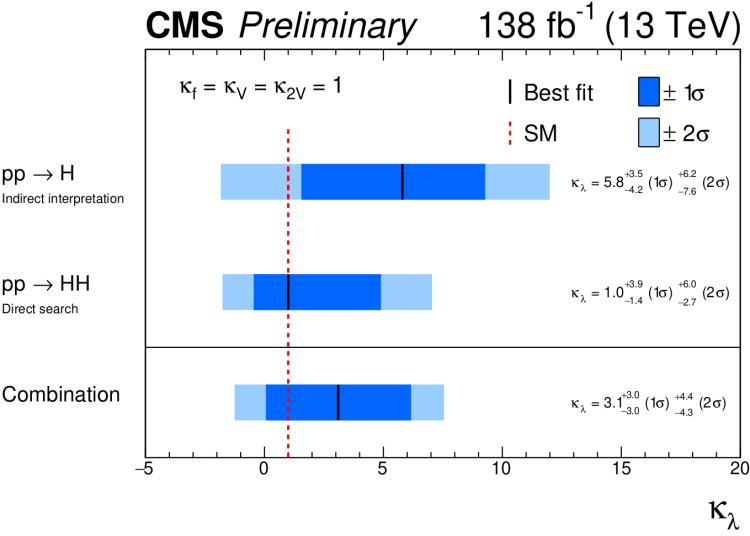
The Higgs boson plays a crucial role in the standard model of particle physics. It is the only particle whose field has nonzero vacuum expectation value. It’s like having a special wave whose status of minimum energy (the “vacuum”) has an average amplitude different from zero. This peculiar property is at the core of the electroweak symmetry breaking mechanism which, among other things, explains why the Z and W bosons (mediators of the electroweak force), and the electrically-charged fermions have mass. The observation of this particle in 2012 by the CMS and ATLAS experiments set a fundamental milestone in particle physics. However, there is still a lot to learn about the unique properties of this particle, such as the precise value of its coupling strengths to the W and Z bosons, and to the fermions. The proton-proton collision data collected by the CMS experiment are fundamental for this study. An intriguing property of the Higgs boson predicted by the standard model is that it interacts with itself! The strength of the self-interaction is controlled by the Higgs boson trilinear self-coupling constant (see Fig. 1). The value of this constant, which is tightly connected with the Higgs boson vacuum expectation value, remains mostly unknown. Therefore, the measurement of λ is an important goal of the CMS Collaboration, as it is fundamental to shed light on the electroweak symmetry breaking mechanism.
Figure 1: On the left, one of the Feynman diagrams for the Higgs boson pair production at the leading order. On the right, an example of a Feynman diagram corresponding to a correction to the Higgs boson production in association with a top-antitop quark pair. The amplitude of both diagrams depend on the Higgs boson trilinear self-coupling constant.
The customary approach for the measurement of the λ constant consists in searching for the production of a pair of Higgs bosons (HH) in the same proton-proton collision. The search for HH is challenging because this process is extremely rare: its production rate, at the LHC, is about 1500 times smaller than the production rate of one single Higgs boson. Furthermore, it is not possible to directly probe the Higgs boson because it decays almost immediately after it is produced. Therefore, we search for the signature of its decay products in the CMS detector. For example, a Higgs boson can decay to a τ+τ- lepton pair, a b quark-antiquark pair, or (through interactions with quarks and W bosons) to a pair of photons. An alternative approach for the measurement of the λ constant consists in performing precise measurements of the production and decay rates of the Higgs boson using its most probable production mechanisms and decay channels. The Higgs boson self-interaction induces corrections to these processes that depend on the value of λ. The corrections are generally very small, therefore accurate and precise measurements are crucial to maximally exploit the proton-proton collision data collected by the CMS experiment.
In order to achieve a precise measurement of λ, the searches for HH and the measurements of the H production and decay rates in the most sensitive channels are statistically combined. This combination also allows a measurement of λ with less assumptions on the Higgs boson couplings to the fermions and to the W and Z bosons, i.e. letting their values deviate from the corresponding standard model prediction. This is quite a reasonable assumption because, if we have some new phenomena not predicted by the standard model, e.g. a yet undiscovered particle which changes the value of λ with respect to the standard model prediction, then modifications are expected at some level in all the other couplings of the Higgs boson. This combination is particularly challenging because of the very large number of input channels: the Higgs boson has many ways of decaying to stable particles! Besides, every channel is affected by many systematic uncertainties that may or may not be shared with other channels. In total we have about 1400 (!) event categories and 16 thousand (!!) sources of systematic uncertainties that must be assessed carefully.
 Figure 2: Test statistic as a function of κλ. The minimum of the curve corresponds to the estimated value of κλ from data, while the crossings of the curve with the lower horizontal line allows us to compute the (asymmetric) uncertainty at 1σ confidence level.
Figure 2: Test statistic as a function of κλ. The minimum of the curve corresponds to the estimated value of κλ from data, while the crossings of the curve with the lower horizontal line allows us to compute the (asymmetric) uncertainty at 1σ confidence level.
The combination yields constraints on the κλ parameter, which is the ratio between the measured value of λ and the one predicted by the SM. The value of κλ is constrained between -1.4 and 7.8 at 95% confidence level, if we assume that the Higgs boson couplings to the fermions and to the Z and W bosons can take any generic values. This means that if we would repeat the experiment a very large number of times, the measured value of κλ should fall inside this interval about 95% of the time. This is the first measurement of κλ under such general assumptions and it was only possible thanks to the large dataset collected by the CMS experiment and by the thorough analyses that have been developed. The precision of the searches for HH is mainly limited by the statistical uncertainties. Therefore, this measurement will largely benefit from the new proton-proton collision data that the LHC is delivering during the ongoing “Run 3” and in the future high-luminosity phase.
Read more about these results:
-
CMS Paper (HIG-23-006): "Constraints on the Higgs boson self-coupling with combination of single and double Higgs boson production "
-
@CMSExperiment on social media: LinkedIn - facebook - twitter - instagram
- Do you like these briefings and want to get an email notification when there is a new one? Subscribe here

